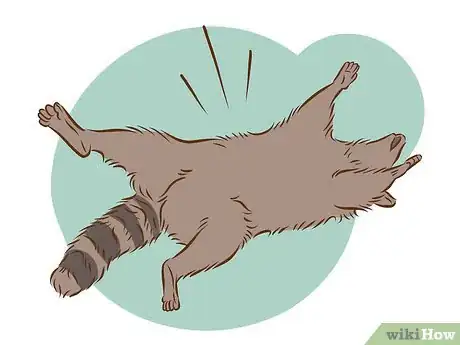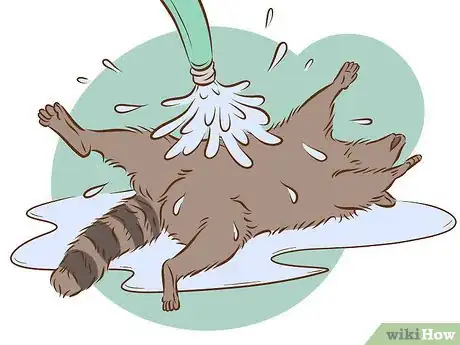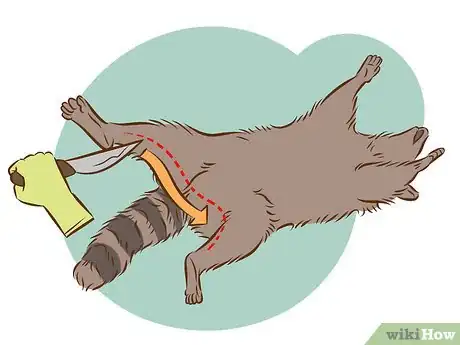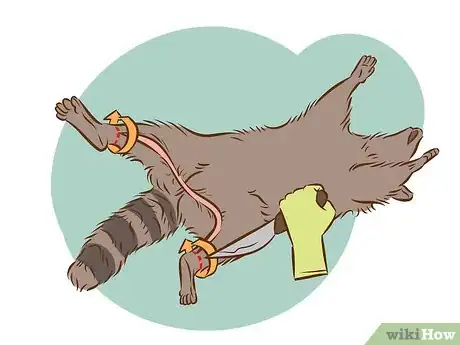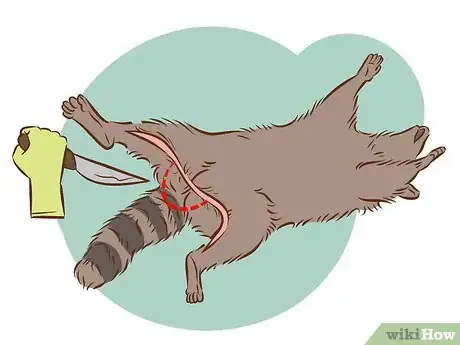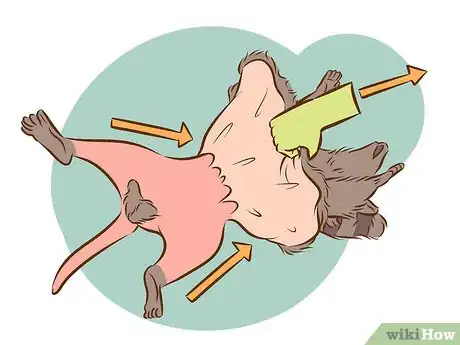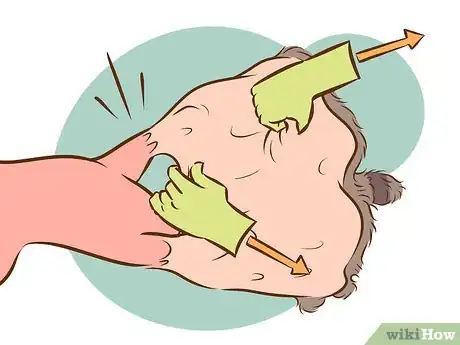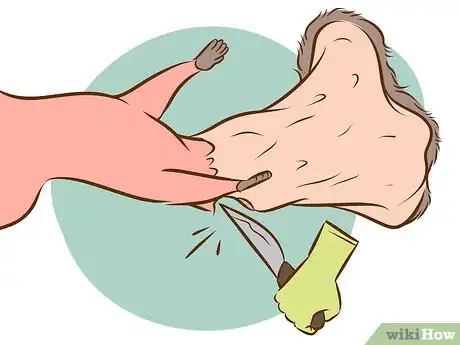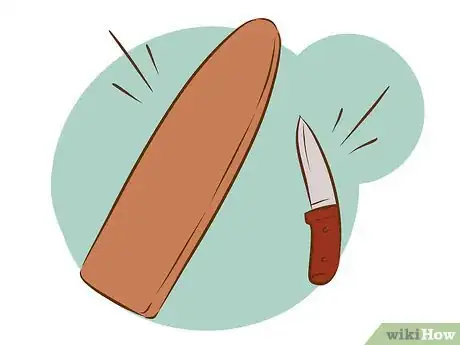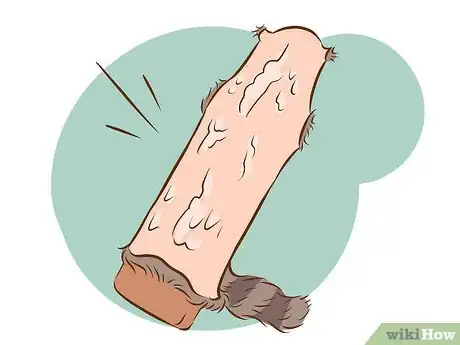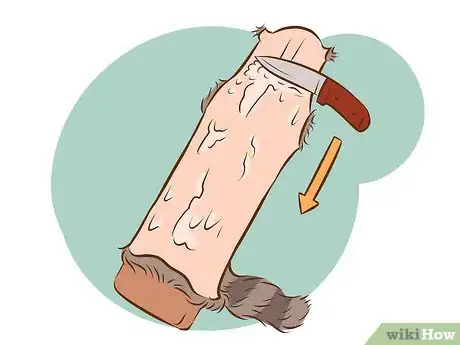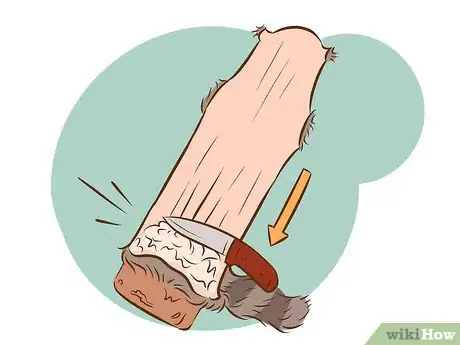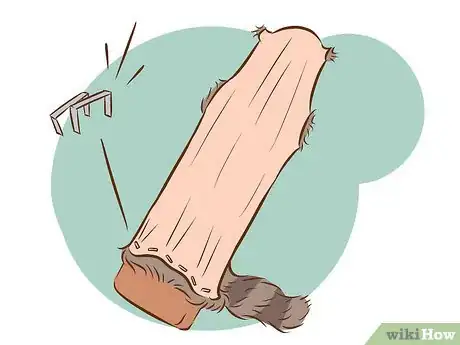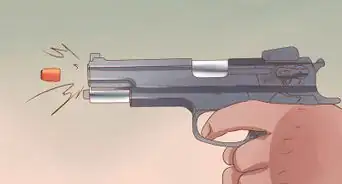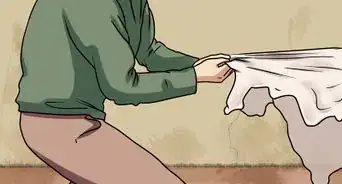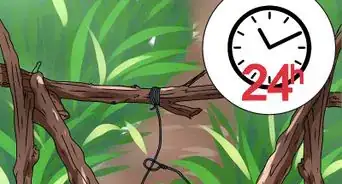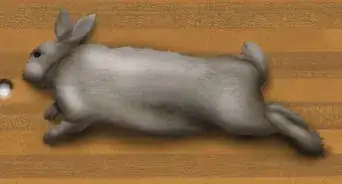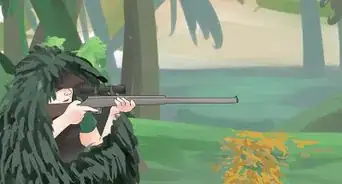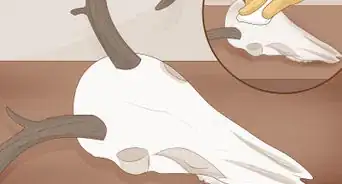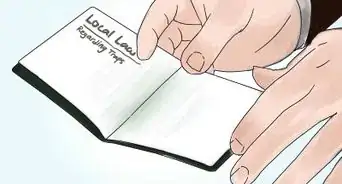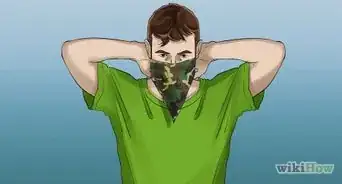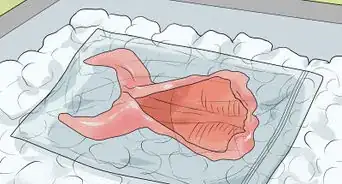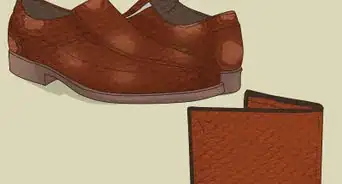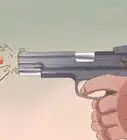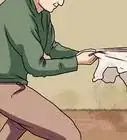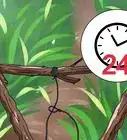wikiHow is a “wiki,” similar to Wikipedia, which means that many of our articles are co-written by multiple authors. To create this article, 21 people, some anonymous, worked to edit and improve it over time.
wikiHow marks an article as reader-approved once it receives enough positive feedback. In this case, 87% of readers who voted found the article helpful, earning it our reader-approved status.
This article has been viewed 132,224 times.
Learn more...
From Davy Crockett's famous coonskin cap to the incorrectly named "sealskin" caps of the British Royal Fusiliers, raccoon fur is useful, fashionable, and iconic. One of the most common and sought-after furs in the fur trade, it's no overstatement to think that raccoon pelts are an integral part of the history of America. Raccoons were even the mascot of the Whig party in the 19th century. If you want to learn this classic skill, you can learn to case the fur properly, scrape it, and stretch it to save the pelt.
Steps
Casing the Fur
-
1Remove the pelt first by casing. When you've acquired game the primary goal of which is the pelt, there are two basic methods of proceeding. Casing refers to removing the pelt from the carcass, starting around the back feet and working forward, pulling it off in one big piece. This is the best way to proceed. It's not usually recommend that you attempt to remove the organs first, which can ruin the valuable pelt.
- Open-skinning is typically only used on beavers and a few other animals. This involves removing the organs first, via a vertical slit up the torso of the animal, then removing the pelt and the tail at once. This isn't recommended for raccoons.
-
2Clean the raccoon thoroughly. Raccoons have a reputation for acquiring a lot of dirt, since they're scavenging creatures, which means you'll need to take a bit of time to clean them before getting started. Hang the carcass from a skinning gambrel by the feet, hooked through the tendon just behind the ankles to clean them.[1]
- If the raccoons appear to be fairly clean, run a hairbrush through the fur in the direction of the tail, end, to get out any debris, twigs, and dirt that might be difficult to see. If the raccoon seems clean, it's ok to start skinning.
- If you've got a muddy raccoon, hose them down until the water runs clear, hang them by their front foot and hose them down until they run clear water, then let them dry thoroughly before starting. If at all possible, it's best to avoid this, because the stiff bristles of the raccoon fur can become a lot more pliable and (to some people) less desirable if you rinse it.
Advertisement -
3Cut from the inside of one back foot to the next in a straight line. To get started, make a cut through the pelt between the legs of the animal, from the inside of one ankle to the next. Think of it like the inseam on a pair of jeans, connecting your cut from one ankle to the next in a "V" shape.[2]
- "Cuff" the incision by running your knife around both "ankles" of the raccoon, loosening the skin. This will allow you to start pulling the skin down clearly.
-
4Cut around the anus. Cut about an inch or so in diameter around the anus, starting at the base of the tail, where it connects to the body. Obviously, it's usually best to wear gloves at all times when you're skinning raccoons.
- Be very careful at this point not to cut too deeply and cut into the meat. The last thing you want to do is puncture the intestines right around the anus, which can taint the fur and the meat, if you want to use it.
-
5Cut down the length of the tail. Run your knife all the way down the length of the tail in a straight line. To keep the pelt as neat as possible, it's important to use caution and be very exacting in your cut. Go slowly and pull the tail taut while you run it straight from the base to the tip.
- For some raccoons, depending on the size, it may be difficult to get all the way down to the tip of the tail. It's common to go about halfway, then use a tail-stripper to hold the fur in place while you pull the tail up and out of the fur.
- To use a tail-stripper, you'll probably have to work the fur down the hind legs and around the hips to expose the base of the tail more easily to get it started. Tail-stripers are common tools that are used in skinning foxes, raccoons, and other animals, and are available at most outdoors outfitters.
-
6Pull the skin down toward the shoulders. If you've ever skinned a rabbit, the pulling the skin down a raccoon is similar, but a little more tenacious. You'll basically just start pulling the fur downward, toward the head, as if you were stripping off a jumpsuit. Keep pulling until you get to the shoulders.[3]
- If you need to use your knife to help the skinning process, remember to always cut behind the skin and into the membrane, not into the skin itself. Don't get reckless and start scraping away with your knife. Go slowly and use pressure to pull the skin, and let the knife ease any difficult parts, disconnecting any stubborn membrane from the flesh.
- On male raccoons, you'll have to cut the genitals away from the carcass using your knife. It'll stay attached to the fur, and you can remove it later during the fleshing and stretching process.
-
7Go slowly around the forearms. When you get to the forearms, it's usually recommended that you put the knife away. It's a fatty area, and gets somewhat difficult to distinguish meat from fur, so it's a better idea to use your fingers and go slowly, avoiding the knife and accidental cuts through the pelt.[4]
- Pull the fur loose around and over the shoulders, down to about the elbow. You can make another cuff cut at that point and separate the fur from the arms. It should now just be attached around the neck.
-
8Cut around the ears and eyes. Expose the face of the raccoon and use your knife to cut around the eyes and the ears. Return your attention to the skin side, and keep pulling the pelt down and free of the flesh, working it up the neck and to the jaw. At this point, you'll probably need to use the knife to run along the top jawline on both sides, to separate the pelt from the mouth. Keep pulling until the pelt comes almost entirely free.[5]
-
9Separate the pelt from the nose cartilage. At this point, there should be a strong point of cartilage that connects the nose to the skin. You're almost done. Just use your knife to cut through it and the pelt should come free in one big piece. Don't pull to hard to try to separate the pelt, because you risk ripping it and damaging the skin. Cut through the cartilage and you'll be done.
-
10Inspect the meat for signs of disease. Raccoons are sometimes eaten, though some sources estimate that as many as 40% of raccoons in North America suffer from intestinal parasites like roundworms, which can make you sick. Raccoons are also scavengers, meaning that they're exposed to a number of diseases and infections. Examine the skin and the flesh of the animal closely for spots, discoloration, or any other signs of infection. If it looks suspect, discard it.
- If you want to try raccoon and determine that the meat is clean, gut the carcass as you would a rabbit. While less popular than certain other wild game because of the strong and some say unpleasant flavor, brining raccoon for a long period of time and cooking it properly is considered by some to be a delicacy. If you're after more than just the fur, you can learn to prepare the meat in the following section.
Fleshing and Stretching the Pelt
-
1Get a scraper and a stretching board. Flesh-scrapers and stretching boards are about as primitive a tool as you can get, but it's still the most effective way for getting the flesh, cartilage, and fatty bits off of the pelt so that it can dry thoroughly.
- A flesh scraper is basically what it sounds like: a short and sharp blade that's used to scrape the flesh away. In a pinch, you could use a big kitchen knife that's somewhat dull, but it might be a little more difficult than with a scraper. Hog scrapers, single and double-handed scrapers are all common.
- Metal and wooden boards are both commonly used for the job. If you use a wooden stretching board, you'll also need staples or push-pins to secure the pelt when you're ready to stretch it for drying.
- Wooden stretching boards can double as "fleshing boards," providing a nice surface to scrape the pelt on. If you have a metal stretcher, you'll just need to use a bench, table, or other flat surface on which to scrape the pelt.
-
2Let the pelt dry some until the fat can harden. It's usually recommended to let the fur alone to firm up the fat some in a cool environment (about 55 degrees F, or 13 C). This will help to make the scraping job a lot easier. You can flatten out the pelt onto the board, fur side down, to let it dry for several hours before you get started scraping. When you start, the whole process of scraping itself shouldn't take more than 15 or 30 minutes.
-
3Start scraping the fat away from the tail. Using firm pressure, carefully scrape the fat and connective tissue away from the skin using the scraper. There's not much of a secret or a science to it–you're basically just scraping. Be gentle to avoid tearing through the skin, but be firm enough and even enough to get everything off.
- The tail is usually the most challenging part, so most trappers will start there, spending the most time making sure that every bit of fat is evenly scraped away.
-
4Remove the rest of the fat. After removing the fat from the tail, scrape directly up the middle of the pelt, in a stripe. Go all the way up until you've scraped everything off a narrow strip up the middle of the pelt, and the head of the pelt. Then go back and scrape outward, extending evenly to the sides. This will help start the stretching process and flatten out the pelt.[6]
- Keep using even pressure and slowly scraping off all the fat and other bits as you work. It shouldn't take that long, but be thorough. If you miss anything, you risk ruining the pelt with rot.
-
5Stretch the pelt onto the stretching board. Metal stretches are usually one-peice mechanisms that allow you to secure the pelt easily without additional tools. With a wooden stretching board, you'll typically need to use push-pins or staples to stretch out the pelt.[7]
- Stretch the pelt tightly, so it flattens out and looks clean, but not so stretched that it thins out the skin and makes it look weak. It'll also shrink some while it stretches, so you want to make sure it'll be able to comfortably.
- The pelt should be starfish-stretched out, all the limbs and the tail taut and extended. Don't let the arms hang loosely, or the pelt won't look right.
-
6Let the pelt hang in a cool dark place. 55 to 60 degrees F (13 to 15 degrees C) is the perfect drying environment for a pelt. Make sure it's free from sunlight and temperature fluctuations. Depending on the climate, pelts should hang for anywhere between a day and a week. You'll know it's done when the skin is firm and taut, with a plastic-like touch.
Community Q&A
-
QuestionIf I freeze it for later, do I need to add salt?
 Community AnswerNo, the freezing temperature will preserve it. Make sure to put it in a plastic bag.
Community AnswerNo, the freezing temperature will preserve it. Make sure to put it in a plastic bag. -
QuestionHow many musk bags are on a raccoon, and exactly where are they?
 Community AnswerThere are none, but there is a gland in the front leg. You do not need to worry about it if you are not eating the meat.
Community AnswerThere are none, but there is a gland in the front leg. You do not need to worry about it if you are not eating the meat. -
QuestionI got cut using a knife I used to cut a coon. Can I get rabies?
 Community AnswerYes, if the knife was not sterilized between the skinning and when you were cut.
Community AnswerYes, if the knife was not sterilized between the skinning and when you were cut.
Warnings
- Don't cut yourself⧼thumbs_response⧽
- You should only kill a raccoon for their pelt if you ALSO plan to eat it. Otherwise, opt for humane options such as cotton or wool.⧼thumbs_response⧽
References
- ↑ http://www.ohiostatetrapper.org/raccoonskinning.pdf
- ↑ http://www.ohiostatetrapper.org/raccoonskinning.pdf
- ↑ https://www.trap-anything.com/how-to-skin-a-raccoon.html
- ↑ http://www.dfw.state.or.us/education/hunter/docs/Fur_Handling_Tips.pdf
- ↑ https://www.trap-anything.com/how-to-skin-a-raccoon.html
- ↑ http://www.ohiostatetrapper.org/raccoonfleshstretch.pdf
- ↑ http://www.ohiostatetrapper.org/raccoonfleshstretch.pdf
About This Article
To skin a raccoon, start by hanging it by the feet, running a hairbrush through the fur to remove debris, and hosing it down until the water runs clear. Next, cut from the inside of 1 back foot to the next in a straight line, and cuff the ankles by cutting the fur around them. Then, cut an inch in diameter around the anus and run the knife down the length of the tail. You can now pull the skin down toward the shoulders and slowly over the forearms. When you reach the face, cut around the ears and eyes to continue pulling the pelt down. To learn how to flesh and stretch the pelt, keep reading!
